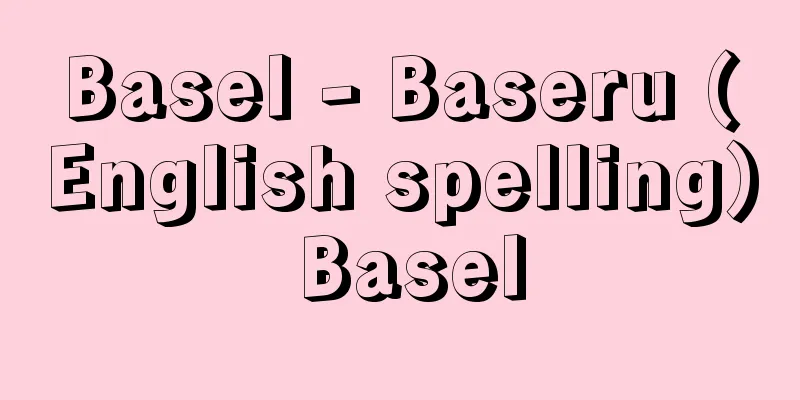Basel - Baseru (English spelling) Basel

|
The capital of the canton of Basel-Stadt in northern Switzerland. Its French name is Bâle. With a population of 164,850 (2001), it is the third largest city in Switzerland after Zurich and Geneva. It developed along the Rhine, which forms the border with Germany and France, and is a key location for river and rail transport. During the Protestant Reformation in the 16th century, the city welcomed Protestant scholars, entrepreneurs, and merchants who fled from France, Italy, and the Netherlands, and this contributed to the city's cultural and economic development. It is currently a major center of the chemical industry (especially pharmaceuticals and dyes), as well as electrical, mechanical, and printing industries. The industrial district is located in Little Basel on the right bank of the Rhine. A large amount of goods are imported and exported through the river port here. Greater Basel on the left bank is the commercial and cultural center, with many things to see, including the cathedral, art museums, and history museums. It is home to the headquarters of the Bank for International Settlements (BIS). [Ikuo Maejima] historyIt was first mentioned in 374 as a Roman camp called Basilea. In the early 7th century, Bishop Augustus moved his episcopal seat here, and it developed as a religious center. In the 9th century, it became part of the East Frankish Kingdom, in the 10th century the Burgundian Kingdom, and later the Holy Roman Empire. In the 14th century, it suffered great damage from disasters such as the plague, earthquakes, and fires, but the city's inhabitants gradually tried to break away from the episcopal rule and obtained the imperial Vogt (governor) position from the Habsburgs. It then grew into a city-state by acquiring the neighboring areas, including Little Basel on the right bank of the Rhine. The 15th and 16th centuries saw a period of cultural and economic prosperity, with the development of trade, the holding of an Ecumenical Council (1431-49), and the founding of the oldest university in Switzerland (1460). In 1501, it permanently joined the Swiss Confederation, and in 1648, it represented Switzerland in the negotiations for the Treaty of Westphalia, which secured the recognition of Switzerland's separation from the Holy Roman Empire. In 1528 and 1529, the Reformation was implemented, the bishop left the city, and thereafter, the citizens and the city nobility repeatedly clashed over city politics. In 1833, the Basel Land was separated and became a semi-canton called Basel-Stadt and Basel-Land. The two cantons are collectively called the Canton of Basel. The Canton of Basel-Stadt has an area of 37 square kilometers and a population of 186,700. The Canton of Basel-Land has an area of 517 square kilometers and a population of 261,400, with the capital Liestal having a population of 12,734 (all statistics are from 2001). [Rumiko Sato] An international bank established in 1930. It promotes cooperation among central banks and plays an important role in coordinating monetary policy and discussing and deciding on international currency issues. Basel, Switzerland ©Masashi Tanaka "> Bank for International Settlements (BIS) Headquarters Source: Shogakukan Encyclopedia Nipponica About Encyclopedia Nipponica Information | Legend |
|
スイス北部、バーゼル・シュタット(Stadt)準州の州都。フランス語名バールBâle。人口16万4850(2001)で、チューリヒ、ジュネーブに次ぐスイス第三の都市。ドイツおよびフランスとの国境をなすライン川沿いに発達した町で、河川・鉄道交通の要地である。16世紀の宗教改革時に、フランス、イタリア、オランダから逃れてきた新教派の学者、企業家、商人らを市民が受け入れ、これが市の文化・経済の発展に貢献した。現在は化学工業(とくに薬品・染料)の一大中心であり、ほかに電気、機械、印刷などの工業が行われる。工業地区はライン川右岸の小バーゼルに立地する。ここにある河港を通じて多量の物資の輸出入が行われる。左岸の大バーゼルは商業・文化の中心で、大聖堂、美術館、歴史博物館などみるべきものが多い。国際決済銀行(BIS)本部所在地。 [前島郁雄] 歴史ローマの野営地バジレアBasileaとして374年に初めて記録に現れる。7世紀初頭、司教アウグストがこの地に司教座を移したことにより、宗教中心都市として発達した。9世紀には東フランク王国、10世紀にはブルグント王国、そしてのち神聖ローマ帝国に帰属した。14世紀にはペストや地震、火災などの災害により大打撃を被ったが、市の住民は徐々に司教支配権からの離脱を試み、またハプスブルク家から帝国フォークトVogt(知事)職を獲得した。そしてライン川右岸の小バーゼルほか近隣地域を獲得することによって都市国家へと成長した。交易の発達、公会議開催(1431~49)、スイス最古の大学の設置(1460)と、15、16世紀には文化・経済の繁栄期を迎えた。1501年にはスイス誓約同盟に永久加盟し、1648年ウェストファリア条約交渉にスイスの代表として参加、神聖ローマ帝国からのスイスの分離承認を取り付けた。1528、29年、宗教改革を実施し、司教は市を退去、その後市民と都市貴族とは市政上の対立を繰り返した。1833年バーゼル・ラント(Land)が分離し、バーゼル・シュタット、バーゼル・ラントとしておのおの準州(半カントン)となった。両準州を合わせてバーゼル州と総称する。バーゼル・シュタット準州は面積37平方キロメートル、人口18万6700。バーゼル・ラント準州は面積517平方キロメートル、人口26万1400、州都リースタルLiestalの人口1万2734(統計はすべて2001年)。 [佐藤るみ子] 1930年に設立された国際的な銀行。各国中央銀行の協力を促進し、金融政策の調整、国際通貨問題に関する討議・決定などに重要な役割を果たしている。スイス バーゼル©Masashi Tanaka"> 国際決済銀行(BIS)本部 出典 小学館 日本大百科全書(ニッポニカ)日本大百科全書(ニッポニカ)について 情報 | 凡例 |
>>: Bāṣeri tribe (English spelling)
Recommend
Renormalization theory - Renormalization theory
In quantum field theory, the incorporation of eff...
Currency Law - Kaheiho
This law was promulgated in March 1897 (Meiji 30)...
Coast Guard
… [Command and Civilian Control] Under the United...
SKD - SKD
《 Semi knockdown 》 Semi-knockdown. A knockdown met...
Crossing Mount Gasan
...Their efforts created the foundation for the n...
Amitābha (English spelling)
...Of the 48 vows, the 18th vow states that one c...
Beltrami, E. (English spelling) BeltramiE
…In this way, differential geometry, which uses c...
Yoshio Tanaka
Year of death: June 22, 1916 Year of birth: Tempo ...
Corallina officinalis (English name: Corallina officinalis)
A species of red algae in the order Crackletia, fa...
Silver Lord
(Noun) (From the Edo period when silver coins were...
Trinil - Trinil (English spelling)
Located in the middle reaches of the Solo River i...
King of the Fens
…He went to London to study law, but returned hom...
Foreign Investment Law
〘Noun〙 Abbreviation for the "Law Concerning F...
Algebraic curve
A one-dimensional (irreducible) algebraic variety...
Social Education Law
This law was enacted in 1949 (Showa 24) to stipul...









